
The garden pansy is a type of large-flowered hybrid plant cultivated as a garden flower. It is derived by hybridization from several species in the section Melanium of the genus Viola, particularly Viola tricolor, a wildflower of Europe and western Asia known as heartsease. It is sometimes known as Viola tricolor var. hortensis, but this scientific name is ambiguous. While Viola tricolor var. hortensisGroenland & Rümpler is a synonym of Viola × wittrockiana, Viola tricolor var. hortensisDC. refers to a horticultural variety of wild pansy that had been illustrated in Flora Danica in 1777 before the existence of Viola × wittrockiana.
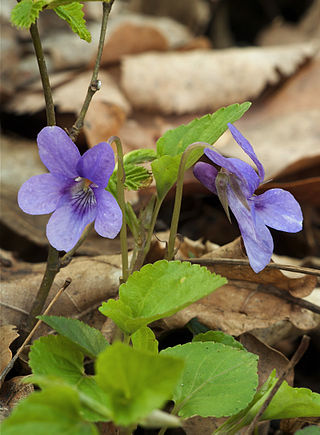
Viola is a genus of flowering plants in the violet family Violaceae. It is the largest genus in the family, containing between 525 and 600 species. Most species are found in the temperate Northern Hemisphere; however, some are also found in widely divergent areas such as Hawaii, Australasia, and the Andes.
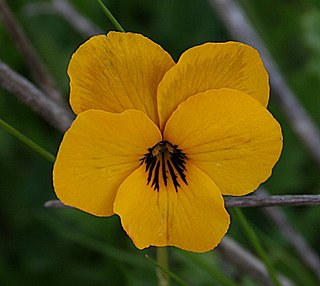
Viola pedunculata, the California golden violet, Johnny jump up, or yellow pansy, is a perennial yellow wildflower of the coast and coastal ranges in California and northwestern Baja California. The common name "Johnny jump up" is usually associated with Viola tricolor however, the introduced garden annual.

Viola canina is a species of the genus Viola, native to Europe, where it is found in heaths, fens, and moist woodlands, especially on acidic soils.

Viola odorata is a species of flowering plant in the genus Viola, native to Europe and Asia. This small hardy herbaceous perennial is commonly known as wood violet, sweet violet, English violet, common violet, florist's violet, or garden violet. It has been introduced into North America and Australia.

Viola lutea, the mountain pansy, is a species of violet that grows in Europe, from the British Isles to the Balkans.

Viola palustris is a perennial forb of the genus Viola. It inhabits moist meadows, marshes, and stream banks in northern parts of North America and Eurasia. The species epithet palustris is Latin for "of the marsh" and indicates its common habitat.

Viola sororia, known commonly as the common blue violet, is a short-stemmed herbaceous perennial plant that is native to eastern North America. It is known by a number of common names, including common meadow violet, purple violet, woolly blue violet, hooded violet, and wood violet. Its cultivar 'Albiflora' has gained the Royal Horticultural Society's Award of Garden Merit. This perennial plant species is distributed in the eastern half of the United States, Canada and a part of Eastern Mexico. Their native habitats are rich, moist woods, and swamps located in the eastern half of the United States and Canada.
NVC community CG10 is one of the calcicolous grassland communities in the British National Vegetation Classification system. Of the upland group of calcicolous grasslands, it is the only one with a short sward associated with heavy grazing.
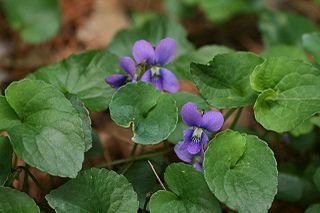
Viola cucullata, the hooded blue violet, marsh blue violet or purple violet, is a species of the genus Viola native to eastern North America, from Newfoundland west to Ontario and Minnesota, and south to Georgia. It is a recipient of the Royal Horticultural Society's Award of Garden Merit.

Viola kitaibeliana, the dwarf violet, is a plant species in the genus Viola. It is native to a large area from the Canary Islands, across Europe, to northern Iran and southern Turkmenistan.
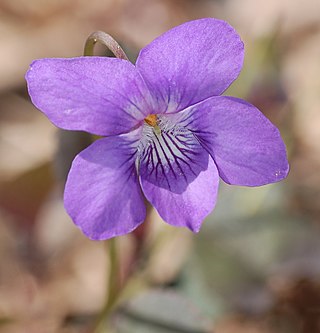
Viola labradorica, commonly known as alpine violet, American dog violet, dog violet or Labrador violet, is a perennial herbaceous flowering plant. It is native to Greenland, eastern Canada, and the eastern United States. The plant sold as Viola labradorica by nurseries is Viola riviniana.

Viola cornuta, known as horned pansy or horned violet, is a species of flowering plant in the violet family Violaceae, native to the Pyrenees and the Cordillera Cantábrica of northern Spain at an altitude of 1,000–2,300 metres (3,300–7,500 ft). It is a low-growing, clump-forming temperate evergreen perennial, reaching 50 cm (20 in) in height and spread. It has mid-green ovate leaves with rounded teeth, and masses of delicate pale violet flowers in early summer. The flower consists of five strap-shaped petals with a slender spur.

Viola flettii is a species of violet known by the common name Olympic violet. Native to the northeastern and eastern Olympic Mountains of Washington in northwestern United States, it occurs on rocky outcrops and talus at subalpine and alpine elevations, i.e., from 1,340–2,000 metres (4,400–6,560 ft), and blooms from June through August. This rhizomatous herb produces a hairless stem reaching a maximum height of a few centimeters to around 15 centimeters. The basal leaves have purple-veined green reniform blades borne on petioles. Leaves on the flower stem are similar but smaller. A solitary flower is borne on a slender upright stem. It has five purplish-violet petals with yellowish bases, the lower three with purple veins. The lateral pair are bearded as is the stigma. The spur on the lowest petal is much shorter than the petal.

Viola sagittata, commonly called the arrowleaf violet, is a species of flowering plant in the violet family (Violaceae). It is native to the eastern North America in Canada and the United States, where it is widespread. It is found in a variety of natural habitats, but is most common in dry, open communities such as prairies, glades, or woodlands, often in sandy or rocky soil.
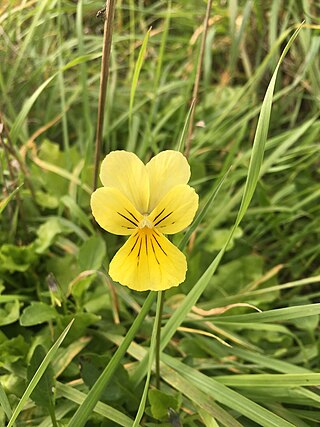
Viola lutea subsp. calaminaria is a subspecies of V. lutea, in the violet family, the Violaceae. The plant occurs from Kelmis in the Belgian province of Liège across the borders to Germany and the Netherlands. The plant has adapted to an excess of zinc in the tailings of a former mines, the heaps of stone left over after separating the valuable fraction of ore. By evolving the ability to cope with the toxic heavy metal pollution, this violet has gained an advantage over the other plants in the ecosystem, as is able to become the locally dominant floral component of such habitats.

Viola hispida is a plant species in the genus Viola. It is endemic to France.
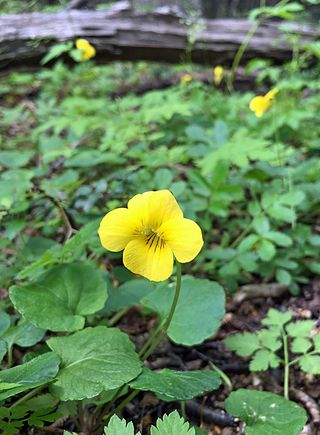
Viola reichei, also known as the Patagonian yellow violet, is a flowering plant species of the genus Viola.

Viola gracilis, also known as the Olympian violet, is a species of flowering plant within the family Violaceae.



















